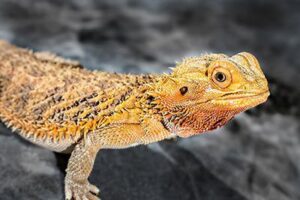Imagine the joy of seeing two crested geckos interacting in the same enclosure, sharing their space harmoniously. It’s a tempting idea for any reptile enthusiast, but before setting up a communal habitat, there’s an important question to answer: Can crested geckos live together?
The answer isn’t as straightforward as it may seem. While some situations might allow for cohabitation, the natural behaviors and needs of crested geckos make solitary living the safest choice for most.
In this article, we’ll dive deep into the complexities of crested gecko behavior, the risks and requirements of cohabitation, and alternatives that ensure your geckos thrive in captivity.
Understanding Crested Gecko Behavior

Crested geckos, or Correlophus ciliatus, are fascinating creatures native to New Caledonia. In the wild, these geckos are solitary and territorial. They prefer to establish their own space, only interacting briefly during mating seasons. Understanding their behavioral instincts is critical when considering whether they can share a habitat.
Solitary Nature
Crested geckos aren’t naturally social animals. While they don’t actively seek out conflict, their territorial tendencies can lead to disputes if another gecko encroaches on their space. This is especially true in small enclosures where resources like food, hiding spots, and basking areas are limited.
Interaction in Captivity
In captivity, the controlled environment adds unique challenges. Unlike the wild, where geckos can escape confrontations, a shared tank offers limited options for retreat. This lack of space can escalate tensions and lead to stress or aggression.
Signs of Stress
Stress is a silent yet significant threat to geckos. Over time, it can weaken their immune systems and lead to health issues. Signs that your gecko might be stressed include reduced appetite, excessive hiding, unusual aggression, or physical injuries.
Factors to Consider Before Housing Crested Geckos Together
If you’re determined to try cohabitation, there are several factors to weigh carefully.
1. Age and Size
Mixing geckos of different ages or sizes is a recipe for disaster. Juveniles are particularly vulnerable to bullying or accidental injury from larger geckos. Additionally, smaller geckos may struggle to compete for food and hiding spots.
2. Gender Compatibility
The gender of your geckos plays a crucial role in determining whether cohabitation might work:
- Male vs. Male: Male crested geckos are highly territorial and prone to aggressive confrontations. Housing two males together often leads to fights, injuries, and constant stress.
- Male vs. Female: While this pairing is common during breeding, it’s not suitable for long-term cohabitation. A male’s constant mating attempts can exhaust the female, leading to health complications.
- Female vs. Female: Female geckos are the least aggressive pairing. However, even this combination isn’t guaranteed to be conflict-free, especially in cramped enclosures.
3. Space Requirements
Adequate space is critical for cohabitation. A small enclosure will intensify competition for resources and heighten stress levels. A minimum tank size of 30 gallons is recommended for two geckos, but larger setups with ample hiding spots are preferable.
4. Hiding Spots and Enrichment
Geckos need plenty of hides, climbing structures, and visual barriers to feel secure. The more complex the habitat, the easier it is for each gecko to establish its own territory within the shared space.
Risks of Housing Crested Geckos Together
Despite careful planning, cohabitation always carries risks. Understanding these dangers can help you make an informed decision.
1. Fighting and Injuries
Aggression between geckos often results in bites, scratches, or tail loss. Even minor injuries can become serious if they’re not treated promptly. Males, in particular, are notorious for fighting when housed together.
2. Stress and Illness
Chronic stress from cohabitation can suppress a gecko’s immune system, making them more susceptible to diseases. Over time, this stress can lead to a decline in overall health and quality of life.
3. Breeding Complications
If a male and female gecko are housed together, excessive breeding can take a toll on the female’s health. Continuous egg-laying depletes her calcium reserves, increasing the risk of metabolic bone disease and other complications.
When and How to House Crested Geckos Together
While solo living is generally safer, there are scenarios where temporary cohabitation might be acceptable.
1. Temporary Cohabitation for Breeding
Crested geckos can be housed together briefly during the breeding season. However, they should be separated as soon as mating is complete to avoid stress and overbreeding.
2. Quarantine Measures
Before introducing geckos to the same enclosure, ensure they’re healthy and free of parasites. A quarantine period of at least 30 days is essential to prevent the spread of illness.
3. Proper Introduction Steps
Introducing geckos to a shared enclosure requires careful monitoring:
- Place them in neutral territory to observe their behavior.
- Look for signs of aggression or stress, such as tail twitching or lunging.
- If conflicts arise, separate them immediately.
Ideal Tank Setup for Multiple Crested Geckos

If you decide to house crested geckos together, a well-designed tank can help reduce conflicts.
Tank Size Recommendations
For two geckos, a 30-gallon tank is the absolute minimum. Larger tanks, such as 40 or 50 gallons, provide more space for individual territories and reduce competition.
Temperature and Humidity Control
Maintaining the right temperature (72–78°F) and humidity (50–70%) is essential for a healthy environment. Use a hygrometer and thermometer to monitor these levels closely.
Essential Decor
Incorporate plenty of hides, vines, and climbing structures to create separate zones within the tank. These features allow geckos to retreat and reduce the likelihood of encounters.
Signs That Living Together Isn’t Working
Even with the best setup, cohabitation might fail. Watch for these warning signs:
- Changes in Eating Habits: One gecko may dominate feeding sessions, leaving the other malnourished.
- Physical Injuries: Bite marks, scratches, or missing tails indicate conflict.
- Excessive Hiding or Stress Behaviors: Constant hiding or hyperactivity can signal distress.
If any of these signs appear, separate the geckos immediately to prevent further harm.
Alternatives to Cohabitation
For most keepers, housing geckos separately is the best option. Here are some alternatives to cohabitation that still allow for interaction and enrichment:
1. Separate Tanks
Providing each gecko with its own enclosure ensures they have ample space and resources. This setup eliminates the risks associated with cohabitation.
2. Interaction During Handling
Geckos can experience enrichment through handling sessions and interaction with their owner. This approach allows them to socialize without the risks of sharing a habitat.
3. Pairing Only for Breeding Seasons
If you plan to breed your geckos, introduce them only during the mating season under close supervision. Once breeding is complete, return them to their separate tanks.
Frequently Asked Questions (FAQs)
Can I Keep Two Males Together?
No, housing two male crested geckos together is strongly discouraged. Their territorial instincts often lead to aggression and fighting.
What’s the Best Tank Size for Two Geckos?
The minimum tank size for two geckos is 30 gallons, but a larger enclosure is always better to reduce conflicts and provide adequate space.
How Can I Tell if My Geckos Are Stressed?
Signs of stress include reduced appetite, excessive hiding, hyperactivity, or visible injuries. Monitoring their behavior is essential when attempting cohabitation.
What Should I Do if They Start Fighting?
Separate the geckos immediately and provide individual enclosures. Clean the shared tank thoroughly to remove any territorial scent marks before reusing it.
Conclusion
So, can crested geckos live together? While it’s possible in specific circumstances, it’s not always the best choice. Their solitary nature and territorial instincts make solo living the safest and healthiest option for most geckos. If you’re set on cohabitation, thorough planning, monitoring, and a well-designed enclosure are essential to minimize risks.
Ultimately, the well-being of your geckos should take precedence. Whether housed alone or together, providing them with a safe, enriched environment will ensure they thrive and bring joy to your life as fascinating and resilient pets.

